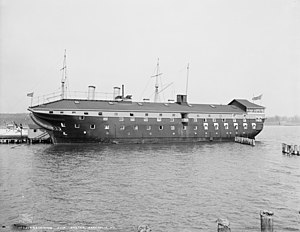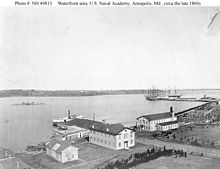USS Santee (1855)
 The USS Santee moored at the United States Naval Academy, 1905 as a Barracks Ship.
| |
| History | |
|---|---|
| Laid down | 1820 |
| Launched | 16 February 1855 |
| Commissioned | 9 June 1861 |
| Fate |
|
| General characteristics | |
| Tonnage | 1726 |
| Length | 190 ft (58 m) (between perpendiculars) |
| Beam | 45 ft (14 m) |
| Depth of hold | 14 ft 5 in (4.39 m) |
| Propulsion | sail |
| Complement | 480 officers and enlisted |
| Armament |
|
USS Santee was a wooden-hulled, three-masted sailing
Service history
Rated at 44 guns, she was laid down in 1820 by the
Shortly before midnight on 7 November, boats left the frigate and entered Galveston Bay hoping to capture and burn the Confederate armed steamer, General Rusk. However, in attempting to avoid detection, the boats ran aground.[1] Since he had lost the advantage of surprise, the expedition's commander, Lt. James Edward Jouett, cancelled his plans to attack General Rusk and turned his attention to the chartered Confederate lookout vessel, Royal Yacht. After a desperate hand-to-hand fight, he captured Royal Yacht's crew, set the armed schooner afire, and retired to Santee with about a dozen prisoners.[1] During the action, one man from the frigate was killed and two of her officers and six of her men were wounded, one mortally.[1] A young 15-year-old sailor named James Henry Carpenter was wounded in the thigh and mentioned in dispatches due to his actions. Carpenter would become Santee's acting Master's mate and would serve again on Santee when she served as a school ship for the United States Naval Academy.[2] Another of Santee's sailors, George H. Bell, was awarded the Medal of Honor for his part in the action.[3]
On 30 December, after a five or six-mile chase on boats from Santee, they captured 14-ton Confederate schooner, Garonne. Captain Eagle stripped the prize for use as a

Refitted at the
Post-war career

In 1866, she became a gunnery ship and was used by midshipmen to master the art of naval gunnery. About the same time, the frigate began to be used as a barracks ship for midshipmen being punished and for new fourthclassmen receiving their first taste of Navy life.[1]
Before dawn on 2 April 1912, after a half a century of duty as an educator, Santee sank at her mooring. Efforts to refloat the frigate proved unsuccessful.[1] She was sold to Henry A. Hitner's Sons Company, of Philadelphia, Pennsylvania, on 2 August 1912, the anniversary of her arrival at Annapolis. After six months of effort, she was finally raised; and, on 8 May 1913, Santee departed the Severn River under tow and proceeded to Boston, where she was burned for the copper and brass in her hull.[1]
See also
References
- ^ a b c d e f g h i j k l m "Santee". Dictionary of American Naval Fighting Ships. Navy Department, Naval History and Heritage Command.
- ^ US Government (2013). "Widow's Pension Claims – Claim 22,296 filed on 19 March 1903, under case #16-611, 113 images". Fold3. Retrieved 21 March 2013. (Note: Much of the history of James Henry Carpenter came from his second wife's pension files)
- ^ "Medal of Honor Recipients, Civil War (A–F)". United States Army Center of Military History. 13 August 2013. Archived from the original on 3 March 2016. Retrieved 30 August 2013.
![]() This article incorporates text from the public domain Dictionary of American Naval Fighting Ships. The entry can be found here.
This article incorporates text from the public domain Dictionary of American Naval Fighting Ships. The entry can be found here.
External links
 Media related to USS Santee (ship, 1855) at Wikimedia Commons
Media related to USS Santee (ship, 1855) at Wikimedia Commons- Journal of the Officer of the Day, U.S.S. Santee, 1864, MS 123 and Journal of the Officer of the Day, U.S.S. Santee, 1865-1866, MS 124 held by Special Collections & Archives, Nimitz Library at the United States Naval Academy
